By Jerry Lips
Reportedly some Luftwaffe prisoners enjoyed more than just a friendly handshake with local New Ulm Fraulein Located near the town of New Ulm, Minnesota, in the majestic Cottonwood forests and bedrocks of shale, sandstone, and marble, stands a famous, large Rustic Style beach house, along with a manager’s residence and garage, built during the WPA National Park Service program in 1934, to put men to work during the Great Depression. These stone structures have been called “the most unusual architectural designs in the state park system” by the Minnesota Historical Society. The architect Edward W. Barber chose to reflect on local culture as well as harmonizing with the local environment, using quarried materials, reflecting local German influences and heritage. Comprised of mostly German immigrants, locals migrated to the Minnesota area from their homeland in the 1800’s to 1900’s to escape oppression, starvation, political and religious freedoms. The immigrants came to New Ulm with great hope; it’s where their language was spoken and their customs and traditions were cherished.
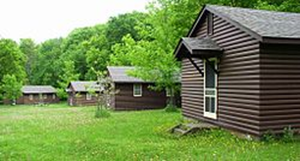
190 Luftwaffe prisoners slept here
Camp New Ulm When WWII broke out, Great Britain was unable to handle the huge influx of prisoners and did not have the resources needed to guard and supply food to them. It was determined that the U.S. would establish camps throughout the country to house the 450,000 POWs who were encamped in non-defense industries. New Ulm was selected for 160 prisoners, most of them Luftwaffe prisoners. A fortunate break for these German Air Force prisoners, as most of the locals still spoke German and were sympathetic towards the prisoners, and both were interested in getting news from the old country on relatives and family. Though guards warned civilians that they were not to have contact with the POWs, church services were held in the camps, and people would slip food over the fences to share with the prisoners. Farmers would provide home cooked meals to POWs assigned to help with farm work and chores at the family dinner table. One documented incident was when prisoner Helmut Lichtenberg arranged to slip out of camp and spend much of a weekend with the American farm family, which was a common practice for the prisoners. The farmer and his mother-in-law drove Lichtenberg into camp that next Sunday afternoon, where guards stopped them. In order to stop those practices and to make an example, Lichtenberg was punished with solitary confinement, and both Americans were fined $300 each and lectured by the judge.
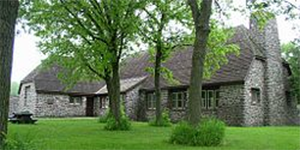
Luftwaffe Prisoners Grandchildren Visit POW Camp
Camp New Ulm had a clubhouse with a fireplace, a library, camp store, sport field and a workshop where POWs made their own furniture and sporting equipment. They were allowed to swim and fish, listen to the radio and enjoy a local newspaper that was printed in German. They even enjoyed going to the movies. Camp New Ulm closed in December 1945 and all internees were eventually repatriated to Germany. Some POWs immigrated back to the U.S. after the war. Several internees were rumored to have enjoyed more than a friendly handshake with local Fraulein and returned after the war to visit German-American-Germans. The New Ulm newspaper has carried several stories of former prisoners and their families returning to visit the unique German town in America that treated the German Luftwaffe so friendly. The Camp remains in use as the state park’s group center where it is still maintained by the forest service.
“As Farm Boys Fought in Europe, German POWs Did the
Work They Left Behind.”
By Curt Nickisch
Gintz is now a retired electrician, living near the cemetery in the small town of Waldsee, north of the Black Forest. He says his time in American custody gave him the political perspective to help build a thriving democracy in Germany. His living room is dotted with woodcarvings of angels. It’s a hobby he began during his free time as a prisoner of war in South Dakota.
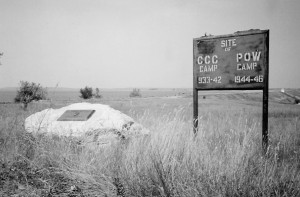
During WWII, many German POWs were interned at the Orman Dam POW camp near Belle Fourche. This is the site today.
The German army drafted Erich Glowania into the infantry when he was 17 years old. The Allies captured him a few months later in Normandy, shortly after D-day.
“As soon as we were in American hands, we had it good,” he remembers. “All of the things we had suffered through before—especially hunger—vanished just like that. Everything was perfect.”

This stencil was used to paint “PW,” for Prisoner of War, onto prisoner clothing at Fort Meade. The stencil is now on display at Old Fort Meade Museum.
Glowania rode the choppy Atlantic on an aging passenger liner. When it pulled into the New York harbor, he and the other prisoners were allowed on deck to see the Statue of Liberty. After docking, they were processed, deloused and marched to the train station.
Glowania and his fellow soldiers were shocked when American soldiers ordered them into comfortable Pullman coaches, and told them to leave an empty seat in each booth of four to keep from getting cramped. In Germany, Glowania and his fellow soldiers had always traveled in boxcars.
Glowania was one of nearly 400,000 German soldiers captured in Europe and North Africa during World War II, who waited out the war in American POW camps set up all over the country. Glowania and other prisoners of war helped fill the massive labor shortage the United States faced because millions of GIs were overseas.

Curt Nickisch interviews Nisland farmer Harry Einfalt, who worked with POWs as a child, and remembers how the prisoners liked to “chase up pheasants.”
This stencil was used to paint “PW,” for Prisoner of War, onto prisoner clothing at Fort Meade. The stencil is now on display at Old Fort Meade Museum.
South Dakota had no major POW camps, but branch camps were set up there by larger camps in neighboring states. By the end of the war, morethan 1,200 German prisoners would toil in that state. Their work ranged fromMissouri River flood control to harvesting sugar beets.
Though they ended up working at four camps on both sides of the “Mighty Mo,” as residents call the Missouri River, which bisects South Dakota, the first POWs that arrived in 1944 helped farm sugar beets in the Belle Fourche Irrigation District, a dry, windswept prairie north of the Black Hills in the western part of the state.
A base camp at Fort Robinson, Neb., established a branch camp at the one-time Civilian Conservation Corps barracks outside Belle Fourche at Orman Dam. Sugar was scarce and had been rationed during the war, so the sugar beet harvest was more important than ever. Moreover, much of sugar beet farming was done by hand at that time, and farm boys fighting fascism overseas werehard to replace.
Curt Nickisch interviews Nisland farmer Harry Einfalt, who worked with POWs as a child, and remembers how the prisoners liked to “chase up pheasants.”
Ninety-one German prisoners rotated to different farms in the district. They would thin the beets for a couple of weeks in the spring, weed in the summer, and harvest in the fall.
David Rathbun still farms the same land that the prisoners worked when he was a child and his father, Jack, was farming it. David’s 13-year-old brother, Grove, or his father would pick up the prisoners in the family’s 1937 one-and-a-half ton Ford beet truck and drive them to the fields near the town of Nisland. David, 9, usually rode up front with his brother and a German sergeant. His mother often followed in their Model A pickup, accompanied by an American guard.
Rathbun remembers the first POW’s as a “real cocky bunch.” They were from Rommel’s elite Afrika Korps, most of them captured in North Africa in 1943. Since that was before Germany really started losing the war, many of them refused to believe what Rathbun and others told them about developments in the war, thinking it to be American propaganda. The prisoners even claimed that New York City had been bombed flat.
“My dad was mowing hay right by the beet field,” Rathbun remembers. “This German sergeant walked over and stood in front of the mower. My dad stopped. ‘For months, Hitler ruled the world,’ the sergeant said as he shook his finger. ‘Where the hell have you been all your life?’ my dad retorted.”
Sometimes, Rathbun and his friends would make fun of the prisoners by goose stepping and giving the Hitler salute until the Americanguard ran them off.

German POWs working on the farm of Jack Rathbun, near Nisland, stop to visit with dog, Jacky, in the back of a Model T Ford. The prisoner at left is holding a beet knife, used during harvesting.
German POWs working on the farm of Jack Rathbun, near Nisland, stop to visit with dog, Jacky, in the back of a Model T Ford. The prisoner at left is holding a beet knife, used during harvesting.
When POWs captured after D-day arrived in the camps with reports of the devastation in Europe, most of the prisoners realized that Germany was losing the war. Some had already come to that conclusion simply because theUnited States had been treating them so well.
America followed to the letter the 1929 Geneva Convention governing treatment of prisoners of war. One of the treaty’s articles says POWs must receive the same amount and quality of food as the civilian population of the host country. The War Department supplied food to the camps and the POWs did their own cooking. They could also buy cola, beer, chocolate, toilet articles, books and tobacco at the camp canteen, with the 80 cents in coupons they earned each workday.
To earn their pay, the prisoners had to fill a certain dailyquota. Harry Einfalt of Nisland, who worked with the prisoners as a child, remembers that the farmers would put a stake in the ground each morning; to let the prisoners know how much ground they had to cover.
An American guard from Brooklyn stands with POWs in Jack Rathbun’s beet fields.
“They knew exactly how far they had to go,” he says. He remembers they worked hard and often finished by mid-afternoon, but they weren’t in too much of a hurry to get back to the barbed-wire camp. Instead, Einfalt says they enjoyed walking around the farm, chasing pheasants and throwing beet knives and rocks to try to knock them down. But he says they always went back to camp empty handed.
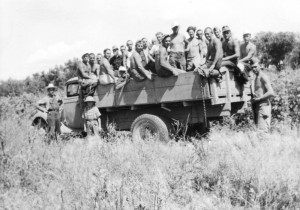
A 1937 ton-and-a-half Ford beet truck is loaded with POWs. The shirtless American guard is at the rear of the truck. Grove Rathbun, 13, drove the truck. His brother, David, 9, is also pictured.
Rathbun also remembers that when the POWs finished work on his father’s farm, they’d go swimming in the Belle Fourche River, which the farm straddles.
“One or two times for sure, the guard would give the sergeant the gun to sit up on the ridge to watch for the staff car,” Rathbun said. “Didn’t want to get caught swimming with the prisoners!”
The Geneva Convention also stipulates that “intellectual and sporting pursuits” are made available to war prisoners. The Germans interned in South Dakota played soccer and handball, put on plays, sang in choirs and enjoyed a library of German language books donated by the YMCA.
The United States was committed to complying with the treaty, because the War Department believed if German soldiers heard from their comrades in captivity how well they were being treated, the men in the trenches might be less likely to resist capture, which would save American lives. Many German commanding officers often threatened their soldiers by saying they would beshot immediately upon capture. That’s what Glowania was told.

POWs, who finished their daily work quota, take a swim in the Belle Fourche River along Jack Rathbun’s farm near Nisland. David Rathbun swam with them a couple of times, as did the American guard.
POWs used long hoes to weed beet rows. Theshirtless American guard shoulders his carbine. The uniformed man is probably the Orman Dam camp’s CO. John Campbell, in a tie, was the field manager for the Utah & Idaho Sugar Company plant in Belle Fourche.
After boarding the comfortable passenger train in New York City, Glowania rode the rails to Algona, Iowa, where the War Department had established a base camp; eventually 10,000 German prisoners would pass through the site. Camp Algona was the source for two branch camps in eastern South Dakota, both established in 1945. Starting on August 30, German prisoners worked in the laundry at the Sioux Falls Army Air Corps Base. The number ofPOWs varied from 174 in September to 218 in November.
Farmers, however, were suffering from the shortage of farm hands, so they approached the War Manpower Commission to request prisoner labor. The commission certified a local labor shortage, authorizing prisoner deployment. Many prisoners from Algona branch camps in Iowa and Minnesota were farmed out to South Dakota agricultural operations. During the 1945 fall harvest, for instance, 190 POWs from Algona’s branch camp at Ortonville, Minn., worked for farmers in Grant and Roberts counties.
A 1937 ton-and-a-half Ford beet truck is loaded with POWs. The shirtless American guard is at the rear of the truck.Grove Rathbun, 13, drove the truck. His brother, David, 9, is also pictured.
Glowania harvested grain and potatoes on farms in eastern South Dakota. He says the work was good, because it kept the prisoners from having too much idle time; only officers and non-commissioned officers were exemptfrom working. Farmers paid the War Department for use of the prisoners. The War Department paid them 10 cents and hour and used the difference to help pay for camp housing and food.
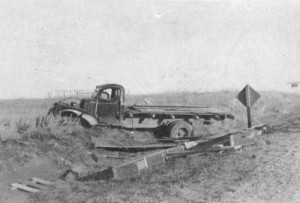
William Pauley was hauling German prisoners from the camp at Fort Meade to the beet fields near Vale, when this truck was involved in a wreck. Several POWs were injured in the crash that occurred four miles outside of Sturgis, on Oct. 17, 1945.
On April 2, 1945, Algona set up a branch camp at Yankton, S.D. Fifty-seven German POWs were housed in a hangar at the “new” airport (the hangar is still used today). Each day, they would ride in trucks or march to where they worked for the U.S. Army Corps of Engineers. John Kabeiseman, then 13, remembers seeing them march from the airport down Douglas Avenue, where two German women would come out to meet the prisoners.
“I don’t think either one was married, or if they were, they were widowed long before I ever knew them,” Kabeiseman says. “They’d give these prisoners freshly baked pies as they walked by. Nobody stopped it or anything.”
POWs, who finished their daily work quota,take a swim in the Belle Fourche River along Jack Rathbun’s farm near Nisland. David Rathbun swam with them a couple of times, as did the American guard.
The prisoners called cadence and sang tunes like the period hit “Lili Marleen” as they marched through town and then across the Meridian Bridge. That was before the Missouri River dams, and the unruly water, especially then during the spring, was gobbling up acres and threatening tocollapse the bridge. The prisoners did rip rapping to protect it, weaving wooden slats into giant mats and weighing them down with stones on the riverbed along the shore to keep the banks from eroding. They also lined the river there with thousands of pylons to divert the river channel from the bridge’s abutments.
Kabeiseman remembers going with his father and another man, both German, and visiting with the POWs through the fence. The young Kabeiseman couldn’t understand German, but remembers his father telling him that the prisoners were concerned about their families in Germany.
The erosion-control work proceeded rapidly, and the camp closed on July 9, when the German POWs were sent to do similar work on the river at Onawa, Iowa.
William Pauley was hauling German prisoners from the camp at Fort Meade to the beet fields near Vale, when this truck was involved in a wreck. Several POWs were injured in the crash that occurred four miles outside of Sturgis, on Oct. 17, 1945.
The camp at Orman Dam was reestablished June 1, 1945, when 215 POWs from Fort Robinson were sent to help farm sugar beets. Another group went to Fort Meade in Sturgis the same day. Of those, 119 helped convert Fort Meade, which had been decommissioned as a cavalry post, into a veterans’ hospital. Another 282 were assigned to help farm sugar beets and harvest potatoes near the towns of Newell and Vale. Ezra Pauley says most people there “were tickled to death to have somebody to get the work done.”
Pauley drove a beet truck to Fort Meade each morning, to pick up a load of prisoners, and took them back in the evening. One time he got a message to stop the truck that was driving ahead of him.
“I was 19,” he says. “I caught up with him and tried to pass him, and he thought I wanted to race with him. These guys were standing up back there, cheering us both on. We went kind of side-by-side all the way to Orman Dam—me trying to pass him and him not letting me. When we got to Orman Dam, a guard saw us coming. To this day—and I’m almost 74—I have never been chewed as hard as that guard chewed me.”
The guard’s concern was justified. Later, on the morning of Oct. 17, 1945, Ezra’s father William was four miles out of Sturgis, when he rolled the beet truck. Several of the prisoners were severely injured and taken to a hospital in Scottsbluff, Neb., but no one was killed. However, two German POWs died less than a month later, in a similar beet truck wreck in Veteran, Wyo.
At first the prisoners were happy to be far from the front, with food on their forks, but once the war was over, they grew anxious to returnhome. South Dakota farmers weren’t anxious about losing the labor, however, and even circulated petitions to hold onto the German prisoners until after the1946 harvest.
But with all of the GIs returning home from overseas, the federal government wanted to make sure work would be waiting for them. No one was interested in returning to the Great Depression. And according to the Geneva Convention, “the repatriation of prisoners shall be effected as soon as possible, after the conclusion of peace.”
The German prisoners would return to find their nation in ruins—a country they’d have to rebuild. And they would have to construct an entirely new political system. Theodor Gintz, who had worked on farms east of the Missouri River, says one of the positive aspects to his POW experience was the fact that he got to see a working and prospering democracy. That was something Germany had never experienced.

POWs used long hoes to weed beet rows. The shirtless American guard shoulders his carbine. The uniformed man is probably the Orman Dam camp’s CO. John Campbell, in a tie, was the field manager for the Utah & Idaho Sugar Company plant in Belle Fourche.
“People in town were on strike, because the price of overalls had been raised a few cents,” he says. “That was unthinkable to us, that the workers would strike. And I realized that this was only possible in a democracy.”
American newspapers also amazed him, when they printed photos of Americans who had died from South Pacific island hopping. A German newspaper would have shown only enemy dead, he says. Gintz and other prisoners sat around the barracks in the evening to talk about what they could do to help build a democracy when they returned. South Dakotans and other Americans would end up helping them, because the generally positive experience with German prisoners of war helped build public support for the costly Marshall Plan that reconstructed Western Europe.
For Kabeiseman, exposure to the POWs meant he learned to separate them from the Nazi stereotype.
“It left a good taste in peoples’ mouths,” he says, “They found out that enemy solders were human beings. I think that came across time andtime again. They were just soldiers doing their jobs; they just happened to be on the opposite side.”
Most of South Dakota’s German prisoners of war were shipped back to the opposite side of the Atlantic by Christmas 1945.
Today, Glowania is a retired pastor living in Cologne, Germany. He still has photos of himself performing in plays at Camp Algona, as well as the letters he wrote home. He credits his capture and time in America for saving his life.











